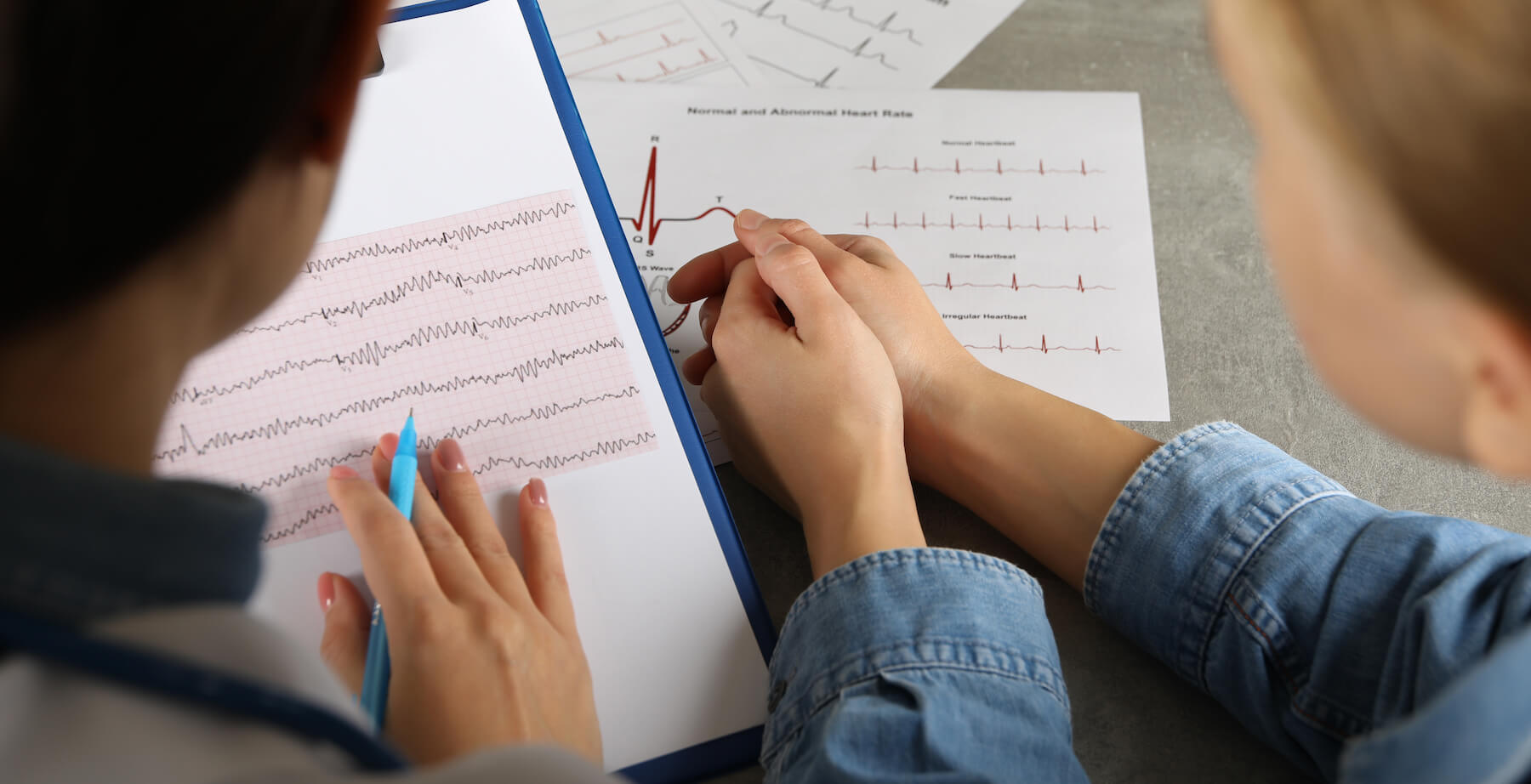EKG interpretation (or ECG interpretation) is a vital diagnostic tool that helps identify various life-threatening cardiac problems. Executive Electrocardiogram Education was designed to help medical students and medical practitioners in all aspects of medical care develop the skills at ECG interpretation that allow them to serve their patients better and advance in their field.
It’s no secret that learning and retention are improved when the learner repeatedly practices the concepts they’ve been taught after a lesson. Whether by taking a quiz on what you’ve learned, applying the knowledge to a practical situation, or even physically employing an action, practicing what you learn is essential to retention.
Our online EKG interpretation courses incorporate multiple ways to practice interpreting ECGs so that you can reinforce your ECG education on a schedule that works best for you. However, if you haven’t yet signed up for Executive Electrocardiogram Education, here are a couple of “offline” methods that you can try.
First Things First, You Should Know the Basics of EKG Interpretation
Before you start interpreting ECGs, you must understand the basics of cardiac rhythms. If you are brand new to ECGs, you may want to take our free ACLS rhythms course first to get a general overview.
Electrocardiograms (ECGs or EKGs) are measurements of the changes in the electrical fields within the heart muscle. An ECG machine detects and graphs these changes. The timing and magnitude of components of the ECG signal for each heartbeat provide clues to patient health. To succeed at ECG interpretation, practitioners must:
- Know the parts of the heart, including the electrical conduction system.
- Understand proper placement of the electrodes for a standard 12-lead ECG and identify changes associated with improper lead placement
- Identify the components of typical ECG waveforms (e.g., P, QRS, and T waves), the different segments, and the intervals.
- Know the conditions that ECGs can diagnose, including abnormal heart rates, heart blocks, arrhythmias, and infarctions.
- Integrate ECG diagnostics into the holistic assessment of patient health
- Understand the real-time application of ECG principles in diagnostic and critical care contexts.
With Executive Electrocardiogram Education’s program, you will learn foundational skills in ECG interpretation and study techniques that will allow you to develop these skills at your own pace in your free time.

Start Your Membership Today
We make electrocardiogram interpretation simple and understandable. The videos are interactive, and have detailed, easy to follow illustrations.
12-lead ECG Tracing
In this course, you will learn the proper way to place electrodes on the patient’s arms, legs, and chest. Each lead provides a tracing or record of changes in the electrical potential at its location.
Identify Heart Rate on the ECG
One essential skill in ECG interpretation is drawing conclusions from the timing of patterns on the ECG tracing. The most critical cyclic pattern in cardiology is the heartbeat. Students learn to measure the intervals and timing of heartbeats. This skill allows students to recognize tachycardia (fast heart rate), bradycardia (slow heart rate), and erratic or changing heart rates.
Identify Axis on the ECG
ECG readers calculate the electrical axis or the direction of electrical conduction. Normal conduction goes from the heart’s upper right to the lower left. Deviations in the axis may indicate cardiac problems. For example, some conditions cause right axis deviation (RAD), left axis deviation (LAD), or even a superior axis, which is entirely opposite from normal.
Students will learn how to determine the axis from ECG tracings and associate the axis measurements with cardiac conditions.
Learn Abnormal Heart Rhythms
In addition to identifying tachycardia and bradycardia, students will identify abnormal patterns of activity, called arrhythmias. Medical convention defines these arrhythmias by where in the heart they originate and then a comment about the heart rate. The course will include atrial fibrillation, ventricular fibrillation, abnormal junctional rhythms, and supraventricular beats with aberrancy.
Learn Chamber Hypertrophies and Bundle Branch Blocks
The ability of ECG to reveal information about the heart without being invasive is key to the technique’s power. Once you have mastered ECG interpretation, you will be able to match ECG tracings with changes in the heart muscle and specific interruptions in conduction.
Learn Acute MI and Ischemic ECG Findings
When patients suddenly lose blood flow to part of the cardiac muscle, they can experience a life-threatening failure of the heart to pump blood through the body. Recognizing the ECG diagnostic markers of myocardial ischemia, injury or infarction can save patients’ lives by allowing doctors, nurses, EMTs, and other medical providers to administer life-saving medical treatments.
Effective Ways to Practice ECG Interpretation
Students in medical programs do not always have the opportunity to practice in contexts that precisely mirror the real-life scenarios they will encounter in doctor’s offices, clinics, and emergency rooms. Textbooks, video instruction, and studying at home remain part of standard medical education.
While Executive Electrocardiogram Education has a variety of practice exams and quizzes built into the platform, here are some other ways you can practice EKG interpretation “offline.”
Utilize Flash Cards For Practice Drills
ECG interpretation draws upon visual memory and recognition. A simple but effective way of practicing learned visual associations is by making flashcards. You can print out sample rhythm strips and tape or paste them onto one side of a flashcard and then write the pattern’s name on the front side.

Start Your Membership Today
We make electrocardiogram interpretation simple and understandable. The videos are interactive, and have detailed, easy to follow illustrations.
You can now use your flashcards to practice EKG interpretation in two ways. Start by looking at a picture of the ECG pattern and naming it. Once you’ve completed your flashcard deck without making any errors, flip your cards over and do it the other way. Start by looking at the pattern’s name and then draw the pattern on a separate piece of paper. By identifying and drawing out each ECG pattern, you will commit them to memory in two ways.
Practice Interpretation with a Partner
If ECG training gets monotonous, why not get together with a friend and train in pairs? There are many practical ways to approach practice with a partner; it just depends on how you best absorb the information.
One method you could try is by quizzing each other on different ECG rhythms and patterns. While similar to the flashcard approach, having a friend be the “examiner” will allow them to change things up on you and test your recall.
Another way that practicing with a partner can be effective is by taking turns teaching each other your own understanding of and approach to ECG interpretation. When you teach a concept to another person, not only are you helping them to understand the material better, but you’re also further reinforcing the retention of the information for yourself.
Create A Reference Guide / ECG Cheat Sheet
Another excellent way for medical students, nurse practitioners, and anyone else actively learning ECG interpretation to study is by creating a reference guide or “cheat sheet.” This guide would contain all of the most important tips, reminders, and information about ECG interpretation you pick up along the way.
Keep in mind that your “cheat sheets” should be a learning tool – you shouldn’t rely on these for actual clinical use. These reference guides should also be visual and informative to help you better identify ECGs at a glance. Draw ECG tracings to illustrate different heart rhythms. The motor memory of drawing and annotating diagrams will help you to focus your attention on the important course concepts and remember them when you need them later on.

Try Our ACLS Rhythm Course For Free!
This course goes through all of the ACLS rhythms. You will be quizzed on each rhythm and then watch the detailed description which points out the salient features.
Take ECG Practice Tests
ECG practice tests are one of the best ways to commit your interpretation skills to memory. Practice tests will help you familiarize yourself with various concepts and ensure you are a master of the concept, not just memorizing one-off information.
While these tests do not necessarily have the format of certification or med school exams, they can help you learn the material, gain confidence in your ECG interpretation skills, and overcome test anxiety.
What Aspects of ECG Interpretation Should You Focus On?
There are different types of ECG recordings that students might encounter in clinical practice. You should practice with each of them so you do not get confused or blindsided.
ECG Rhythm Strip Interpretation Practice
Rhythm strips are short tracings of the heart’s electrical activity, usually viewed from 1 to 3 vantage points. Rhythm strips are used to identify heart rhythms. With these strips, you can determine the heart rate, identify heart blocks, and whether the cardiac rhythm is normal or abnormal. Rhythm strips may be static and shown to you on a piece of paper, or they may be dynamic and seen on a telemetry monitor in real-time.
12 Lead ECG Interpretation Practice
A 12-lead electrocardiogram shows the heart’s electrical activity from 12 different vantage points and demonstrates the rhythm. Just like buying a new car, you want to walk around it and see all sides. A 12-lead electrocardiogram is like taking “a walk around the heart.” Understanding the patterns allows you to decide if the heart is healthy or has a problem.

Start Your Membership Today
We make electrocardiogram interpretation simple and understandable. The videos are interactive, and have detailed, easy to follow illustrations.
Practice ECG Interpretation Online at EcgEdu.com
Executive Electrocardiogram Education gives you the benefit of a dedicated instructor with decades of experience and a full complement of time-tested instructional materials to help students of all backgrounds and levels of experience to master ECG interpretation.
We offer several great online courses to help you master EKG Interpretation. Whether you’re a doctor or medical professional looking for continuing medical education, a medical student looking to master ECG concepts, or even a nurse practitioner, nurse, or other medical professionals, we have a course for you.
Feel free to start with our free ACLS Rhythms course to get a feel for how our videos work and how Dr. Siegal teaches. Suppose you’re ready to try one of our paid courses. In that case, the Arrhythmia Course is an excellent option for nurses, EMTs, and telemetry techs that want to learn the essentials of arrhythmia interpretation. We also offer our ECG Gold and ECG Premium courses which provide our complete step-by-step approach to reading ECGs and access to all of the other courses on our website.
Don’t hesitate to contact us if you have any questions about our courses or our subscriptions.




